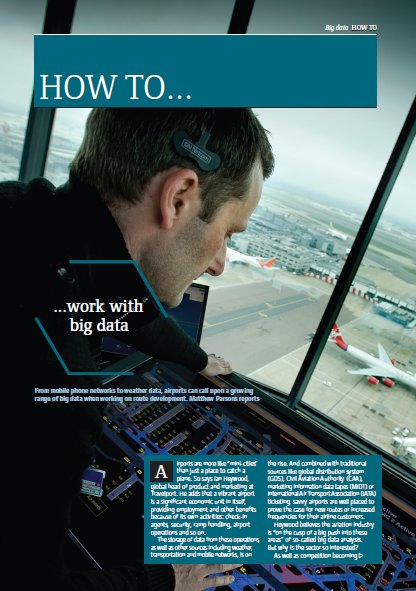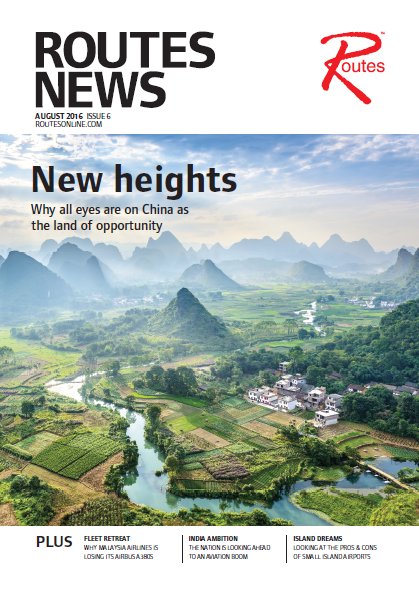From mobile phone networks to weather data, airports can call upon a growing range of big data when working on route development. Airports are more like “mini-cities” than just a place to catch a plane. So says Ian Heywood, global head of product and marketing at Travelport. He adds that a vibrant airport is a significant economic unit in itself, providing employment and other benefits because of its own activities: check-in agents, security, ramp handling, airport operations and so on.
The storage of data from these operations, as well as other sources including weather, transportation and mobile networks, is on
the rise. And combined with traditional sources like global distribution system (GDS), Civil Aviation Authority (CAA), marketing information data tapes (MIDT) or International Air Transport Association (IATA) ticketing, savvy airports are well placed to prove the case for new routes or increased frequencies for their airline customers. Heywood believes the aviation industry is “on the cusp of a big push into these areas” of so-called big data analysis.
But why is the sector so interested? As well as competition becoming fiercer, one reason is changing booking behaviours. Christophe Imbert, co founder of consultancy Milanamos, says: “Airports tend to use their own traffic data and mix them with GDS booking data, aggregated at a monthly level… one of the benefits of GDS data is to analyse origin and destination traffic patterns to understand through which hubs traffic is split."
“However, the issue with GDS data is that it does not reflect direct online bookings representing 60% of the traffic, according to 2012 IATA data, and low-cost carrier (LCC) traffic representing 45% of European capacity,” he adds.
Pete Downes, head of aviation at Bristol Airport, agrees: “With so much LCC traffic sitting outside the GDS environment, and Europe’s LCCs set to drive much of the traffic growth, fare-scraping tools, for example, are becoming more effective at showing the forecast yield on a particular market, as well as highlighting which of our existing routes perform well enough to sustain increased capacity or competition.”
Travelport’s Heywood also says the rise of online travel agency (OTA) bookings must be factored in: “The working assumption has been that geographic location of the travel agency was synonymous with the location of the passenger. Now with so much of the booking and ticketing being done by remote OTAs, a big portion of that insight has been lost. The method is still used, but the volume of bookings going through the bricks and mortar [agencies] is smaller. This makes the analysis and supporting assumptions that go into them more complex.”
However, he adds: “Our new passenger name record (PNR) database stores much more detailed data for every PNR than MIDT traditionally has and may well be a great source we can use for these types of analysis. Because of the passenger data we store there, we are going to explore if we can extract this in an anonymised way to identify the true geographical source of the passengers irrespective of agency used.”
So where else can airports turn? Heywood returns to the mini-city analogy, with other economic activity comprising parking, restaurants, bars, retail, hotels, barber shops, telecommunications and IT services.
He says: “There are also all kinds of new big-data type capabilities coming online that contain enormous amounts of details about the passengers passing through the airports. Our PNR database is one example, but airline manifest data, airport security systems, retail store and credit card data have all kinds of information… as well as mobile networks, plus rail and bus data.”
One company, Weve, is currently helping organisations tap into mobile data. “The profiling of customers entering an airport and where they fly to is a perfect match for operators; they hold detailed information on their customers, their mobile behaviours and also their roaming abroad habit,” says John Finlayson, Weve’s head of brand and business development.
“Mobile behaviours also offer insight into whether there are concentrations of audiences likely to want to travel to a specific country – the mobile calls and texting, plus browser history, can help identify groups that regularly interact with certain countries and therefore have a high propensity to travel there,” he adds.
He says companies such as Telefonica’s Smart Steps can help airports understand their customers, while the first-party data operators’ hold on customers, relating to both where the mobile phone contract is held and where their habitual locations are seen, can be used for accurately mapping an airport’s catchment areas.
“It can even show the mode of transport to the airport, whether it is by car, train or connecting flight via the speed that the individual travels to the destination. This can help with understanding travel patterns, planning connections and also accurately identifying the places to invest media spend when attracting customers for car parking or new route launches,” Finlayson adds.
Another area of interest for airports is ‘leakage’ – where they seek to measure how many passengers from their catchment areas are using competing airports. For Bristol Airport’s Downes, leakage analysis is more significant to the south‑west airport than, say, GDS data, because seven million people a year are travelling to and from the south-west of England by road or rail to use London airports.
“For airports in the north of England or Scotland, GDS data on traffic flowing through the London airport system would be more pivotal in terms of demonstrating the case for a new direct route,” he says.
“On surface leakage, UK CAA passenger survey data is helpful. It demonstrates that as we have built up our European route network to more than 100 destinations, our surface leakage has remained the same in overall volume terms, but shifted more towards long-haul destinations. This helps us understand where and how we should be increasing feeder flights into key European hubs, but also which long-haul routes directly from Bristol are now commercially viable,” he adds.
Meanwhile, weather is increasingly being factored in to modelling by airports. London’s Heathrow Airport works with air navigation provider NATS to take into account weather patterns, airspace restrictions and other data sources to predict aircraft arrivals and departures, enabling more proactive decision-making and management of resources.
Nick Beresford, integrated planning and performance manager, Heathrow Operations, says the airport is in the process of “identifying and liberating
key data sources, which I hope will lead to a data explosion which will be the catalyst for many new big data applications”. Heathrow Airport has collaborations with University College London (UCL) and the University of Virginia’s Darden Business School in the US, to explore the opportunity to predict delays to aircraft departure times due to connecting passengers.
Meanwhile, a proof of concept study by custom information technology, consulting, and business process outsourcing services specialist Cognizant is being carried out to demonstrate the relationship between multiple operational metrics and the passenger experience, as measured through quality service measure (QSM) surveys.
Beresford says: “While all of these projects are being done in collaboration with others, Heathrow is positioning itself to be far more capable of handling and gaining insight from very large data sets. A huge amount of data is generated at the airport, and more exists off-premise which we want to tap into, but much of it is in repositories that were not designed to readily integrate with new systems.”
NATS’ Airport Capacity Management (ACM) tool is also supporting optimal operations at the London airport. The ACM tool was developed in response to an open tender from Heathrow Airport for a new airport capacity declaration and airline schedule coordination process. Launched in April 2014, it “revolutionised the process for agreeing seasonal airlines schedules at the airport”, according to Nick Stevens, senior solution architect at NATS. In 2015 it was key to opening up the first new early morning slot at Heathrow Airport in over 20 years.
ACM allows airports and airlines to quickly understand the operational impacts, such as achievable airport throughput and levels of delays, relating these to changes in scheduled demand, infrastructure changes, or operational changes. “Key data elements include surveillance data, airport operations data, airport ATC systems data; the operational insight and understanding that can be gained from analysing the data is the critical factor,” says Stevens.
As an example, he cites time based separation (TBS) – an airport approach tool that separates aircraft by time instead of distance, based on the wind conditions. “It allows us to maintain the landing rate in headwinds by safely reducing the distance,” he says. At Heathrow Airport, it is estimated TBS saves 80,000 minutes of delay per year.
Despite the wealth of new avenues to explore, Bristol Airport’s Downes believes local knowledge remains key. For example, it maintains a database of corporate travel within Bristol’s catchment. “It’s one of the key pieces of insight that airlines struggle to access at a localised level, given the geographic scale of their markets,” he says.
“While there’s a lot of legwork involved in keeping data updated and relevant in terms of destinations, journeys per month and loyalty scheme memberships, it’s one of the elements that airlines we approach consistently place a high value on, so it’s worth the investment.
“We’ve recently migrated this into a Microsoft Dynamics customer relationship management system to make it work harder for us in future. For a seven- million passenger airport, it represented a significant investment which highlights the importance we place upon it. Whether it’s CAA data, MIDT, market research or anything else, the key principle for us is to combine the data with local knowledge, insight and experience – without that, it’s largely useless.”
While there may be a wider range of data streams available, to help airports in their viability studies for airlines, costs remain a challenge. As Travelport’s Heywood says: “Only the biggest airports have the expertise and wherewithal to do all this themselves. These are usually one-off projects, or certainly not undertaken on a daily basis.”
Yet as the global aviation sector continues to rebound, now might be the perfect time for airports to look at the options, and unlock the potential of big data.
 |
This article is modified from an original feature that appeared in... ROUTES NEWS - ISSUE 6, 2016 PLEASE CLICK HERE to view the magazine. |
 |





